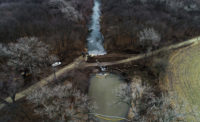Ten days after Superstorm Sandy—a deadly, devastating late-season weather system—made landfal, construction industry participants from across the country joined overwhelmed public officials to restore crippled infrastructure and reshape an altered landscape in New York, New Jersey and nearby states.
Crews also were dealing with as many as 300,000 new customer outages in the wake of a Nov. 7 nor'easter storm that dumped from 3 to 8 inches of wet snow in the already hard-hit region. As of Nov. 9, about 761,418 customers remained powerless, down from 8.66 million when the storm hit on Oct. 29.
The added bad weather followed the earlier massive storm system, which raked a multistate region with high winds and rain, also causing deadly storm-surge flooding that incapacitated train lines, tunnels, treatment plants and power substations.
Inland areas coped with the effects of up to 33 inches of snow.
Gregory Daco, a senior economist for IHS Global Insight, told the National Association for Business Economics that Sandy's cost in structural damage and business interruption could be $30 billion to $50 billion.
Restoring power has been a critical priority. Despite progress, New York Gov. Andrew Cuomo (D) continued to take a hard line with utilities, last week threatening to begin proceedings to revoke utility franchise licenses unless they restored power more quickly. He said it wasn’t enough that they had restored 90% of customers ten days after the hurricane hit.
“Ninety percent only matters if you have the power on,” he said. “There is only one number that matters to people and that is their number. Ninety percent is not a victory. We will keep working and pushing these utility companies every day until that number is zero. Period.”
In the New York City area, Consolidated Edison had brought 1 million customers back on line by Friday with 45,000 still to go.
New Jersey experienced the largest power outage in its history from Hurricane Sandy, according to the Energy Information Administration. PSE&G, the state's largest utility said it expected to have power restored by Nov. 10 to 99% of the 1.7 million customers left in the dark by the storm.
Some 20,000 customers were restored Nov. 8 when repairs to the Sewaren substation were completed.
PSE&G is considering changes the company needs to take to address the "new normal" of harsher, more frequent storms, said Ralph LaRossa, president.
Jersey Central Power & Light did not expect to restore power to its 167,000 remaining customers in the middle of the state and along the coast until the week of Nov. 12.
The Long Island Power Authority had restored power to about 80% of its customers before the snowstorm. About 173,000 remained without power Friday morning in flooded areas, many unable to safely receive power, LIPA said.
Three nuclear units in New York and New Jersey shut down as a result of the storm but two are back on line. Initially, the storm knocked down a power pole at Nine Mile Point 1 on Oct. 29, tripping switches that shut down the plant. Constellation Energy brought the Scriba, N.Y., nuclear powerplant back on line, but shut it down on a second time on Nov. 3 because of a problem with its feedwater control system, says a spokeswoman for the Baltimore-based operator. She declined to estimate when the powerplant would be operational.
Contractors based in the damaged zone pulled in additional personnel, joined by utility workers and companies well beyond, in a widespread repair and restoration effort. One electrical worker from Michigan was told only to head east "until you get to the ocean."
The island drew about 14,000 workers to assist with restoration from throughout the country.
First Response Team of America, a Pennsylvania-based group that provides emergency assistance to small municipalities, was already in place in Long Island, N.Y., before the storm hit, says organizer Tad Agoglia, a former contractor. His group is supported by Caterpillar and several other equipment suppliers. "We do this all over the country," he says.
New York City-based E-J Electric starting gathering electrical workers and equipment as Sandy grew in strength but we "expanded our search to [union] locals as far south as Florida and as far west as Arizona," says CEO Anthony Mann.
O'Connell Electric Co. dispatched 116 workers and 68 pieces of equipment and vehicles from its upstate New York base near Rochester, to metro New York City. Says CEO Victtor Salerno, "outages in areas that would normally take a day or two to restore are taking a week because the resources are spread so thin."
Indiana-based Townsend Corp. dispatched 573 employees in 211 crews in stricken states for line clearance and construction, from locations in Pennsylvania, Kentucky, Indiana, Michigan, Missouri, Louisiana, the Carolinas and Georgia, says company spokesman John Roselle. "Crews are working 12-16 hour days," he says. "Conditions in some areas are still very bad in terms of the damage and people who are in the cold without power."














Post a comment to this article
Report Abusive Comment